AH-GC30
back to Denon
back to measurements
home
published: Mar-02-2023
NO SMOOTHING is applied to the shown plots. Most measurement sites have some smoothing applied which ‘irons flat’ sharp peaks and ‘wiggles’. I do not use smoothing because some info about sound quality is lost when plots are smoothed.
Aside from a small correction of the microphone itself also some correction in the lowest frequencies is applied to the plots to compensate for the perceived loss of bass when using headphones. This is described HERE in more detail.
A ‘horizontal‘ frequency response curve on the shown frequency response plots on this website thus indicates a perceived ‘flat’ tonal signature.
ALL measurements are made with a good SEAL on a flatbed measurement rig.
The shape of your head, bone structure, pad size, pad ‘softness, (compliance), hair or no hair and or wearing glasses may (drastically) change the frequency response of some headphones, so… your personal experience may differ substantially from these plots.
Frequency response (tonal balance) is the most sound-determining aspect of headphones. A horizontal line shows audible neutral response in the plots on this website. Deviations in different severity at different frequency bands have an effect on the sound character.
The bigger the deviation the stronger the effect.
Below an aid to help determining the sound character of headphones with relation to the frequency response.

Denon AH-GC30 (noise cancelling)
 The Denon AH-GC30 is a Noise Cancelling wireless headphone which is well suited for traveling by public transport, planes and in the office or at other places where one wants to drown out outside noises. The noise cancelling function works decently for blocking out low frequency noises such as hum from engines, computer fans, airco’s etc. It was launched in 2019 as the successor of the AH-GC20.
The Denon AH-GC30 is a Noise Cancelling wireless headphone which is well suited for traveling by public transport, planes and in the office or at other places where one wants to drown out outside noises. The noise cancelling function works decently for blocking out low frequency noises such as hum from engines, computer fans, airco’s etc. It was launched in 2019 as the successor of the AH-GC20.
The AH-GC30 has an MSRP of around € 350.- but can often be found for around € 250.-
It looks very similar to the AH-GC20. The build quality looks nice and has a luxury feel. Metal parts are used in the yokes and headband. The whole headphone looks and feels like a ‘quality’ product. The cups have a rubbery texture. My experience with those ‘rubber feeling’ coatings is that over time it becomes a sticky mess that comes off and looks and feels gross. I have no idea if this material suffers the same faith though.
The AH-GC20 has silver colored yokes, the AH-GC30 has light-grey colored yokes.
Operation buttons work different as well.
The comfort is quite good. The headphone is fairly lightweight for a wireless headphone with metal parts. Weighing only 287 gram means it can be worn for longer periods.
The headband is covered with soft, rubbery feeling pleather and feels pleasant even on bald heads. It can’t be taken off and washed so may be accumulating ‘stuff’ over time. Pleather headbands can easily be cleaned with some watery soap.
The pads feel soft and will accommodate most ear sizes and shapes. They feel comfortable but can feel a bit warm and sweaty after a while. They don’t feel like the usual ‘pleather’ pads (vinyl/PVC covered cloth) which starts to flake after a few years.
These pads have some kind of rubber covered cloth and feel very soft. The soft foam inside the pads is slow memory foam.
This foam together with the soft rubber material ensures a good seal and wearing comfort. The pads, however, do not seem to be replaceable so when the pads are worn they can’t be replaced easily. Maybe the Denon service department can replace them.
Chances are that by the time the pads need replacement the also non user replaceable battery also will be depleted as well.
This headphone is clearly intended to be used by the wireless connection. It connects via Bluetooth. Bluetooth 5.0 Dual Mode and is compatible with the following profiles: A2DP/AVRCP/HSP/HFP.
It supports aptX HD/aptX/AAC/SBC codecs.
On a full charge of its non replaceable LiPo battery it operates approx. 20 hours with Bluetooth and Noise Cancelling on.
It takes about 3 hours to charge it fully from a micro-USB port. This port is on the right earcup and, unlike the GC-20 not covered. This means dirt can get inside and cause problems when charging.
The headphone has quite a few buttons. On the left cup there is a button for taking calls.
On the right cup are all the buttons that are related to playing music.
There are volume up and down buttons, a noise cancelling on/off button and the usual music player functions: Pause/play skip forward/backward and fast forward and reverse during play.
The AH-GC30 comes with 2 thin 1.3m long 3.5mm cables. One for listening only (angled 3.5mm TRS jack) and one 1.3m long cable with a mic/remote in it and 3.5mm TRRS cable which allows usage with a phone/tablet/laptop when the battery is depleted and you still want to use it passively.
The connector is designed to be used with Apple products (CTIA standard) and may not work well with some other devices (OMTP standard).
There is also a 1.2m USB to micro-USB cable included for charging but can also be used to connect with data turning the AH-GC30 into a USB DAC/amp/headphone combo.
A sturdy headphone case and small bag for accessories is also included.
No 6.3mm adapter nor airplane adapter (which was supplied with the AH-GC20).
Aside from the LED indicators for various functions there is also a friendly English voice informing you of various aspects.
The Noise Cancelling function has 3 modes. The first mode (LED flashes once) is the airplane mode which drowns out most of the noise. When you toggle to mode 2 (LED flashes 2x) you enter ‘city’ mode.
This mode mixes outside noises so you can still hear some surrounding sounds, be it attenuated.
When you toggle it the third time (LED flashes 3x) you enter the office mode.
All 3 different modes also affect tonality but stay effective with drowning out lower frequencies.
Tapping twice on the right cup switches off N.C. until you tap it twice again. Handy when someone wants to say something to you. Still not very polite as the person in front of you can’t know if and how well they can hear you.
When using wired in active mode the volume controls work. The sound of the headphone drastically changes in passive mode and is basically only there to allow usage when the battery is depleted.
You can still use the headphone when charging.
A bit about Noise Cancelling
The way Noise Cancelling works is by using a microphone inside each cup.
That (small electret) microphone signal is amplified. This is the reason/cause for the audible noise that can be heard during silence or very soft passages in most NC headphones.
The better (read lowest noise) the microphone and microphone pre-amp are the less audible noise there will be with N.C. on.
The AH-GC30 has low self noise and is just barely audible when there is no music playing.
The microphone inside the cup ‘listens’ to ALL sounds in the ‘ear chamber’ and thus picks up the music playing AND the, attenuated by the pads and cups, outside noises as well.
There are also microphone(s) on the outside of the cups but these do nothing for the Noise cancelling and are solely there for taking/making calls.
The Noise Cancelling trick works as follows.
The ‘inner microphone’ listens to what is ‘heard’ inside the cups and compares this to ‘silence’.
It then applies the ‘opposite’ signal to the driver in order to make the final result ‘silence’.
This is as good as ‘instant’. Audio is a very ‘slow’ signal for electronics.
So if the microphone picks up sounds that should not be there the opposite signal is applied to the speaker.
That’s what the Noise Cancelling circuitry inside ‘aims’ for.
of course this isn’t ‘perfect’ as only sounds near the microphone are compensated (for a big part). This only works for lower frequencies because phase differences become a problem due to the speed of sound and the wavelengths of these frequencies.
Instead of total silence we want to listen to music. The applied music signal is added to the ‘reference silence’. This way the music signal IS now the ‘reference’ to which the N.C. circuit aims for.
The microphone ‘measures’ the acoustical signal inside the cups and compares that to the applied music signal. When the headphone driver/acoustics itself ‘colors the sound’ or outside noises enter the cups the microphone + N.C. circuit corrects the ‘errors’. Not only the unwanted outside noises are attenuated (by applied anti-sound) but also the reproduced audio is a LOT closer to the actual applied signal.
This can easily be seen in the frequency and distortion plots further down this article.
It actually works the same as ‘Motion Feedback’ in speakers.
The better (the more linear in FR and less distortion) there is from the driver, the less ‘compensation’ is needed as well.
In the end, N.C. attenuates (not removes completely) outside noises and the added bonus is the acoustical music signal is a closer ‘copy’ to the applied electrical music signal.
Some manufacturers apply a small tilt or bass boost, Denon is definitely one of them as the bass is boosted.
specifications:
Type: Over ear, closed, Noise Cancelling, Bluetooth
Usage: Home, portable
Driver type: dynamic
Pads: NON-replaceable, pleather, slow memory foam
Internal pad dimensions: height: 56mm, width: 40mm, depth: 21mm front, 24mm back
Collapsible: yes and both cups fold flat.
Headphone connector: 2.5mm TRS
Cable entry: single sided (right side)
Cable: replaceable, 1.35m with gold plated angled 3.5 mm TRS plug
Driver size: 40mm Ø
Nom. power rating: 1W
Max. voltage: 5V
Max. current: 180mA
Max. S.P.L.: (passive mode) 130dB
Max. S.P.L.: (active mode) 119dB
Impedance (bot passive mode): 26Ω dropping to 13Ω above 1kHz.
Efficiency: (passive mode) 101dB @1mW, 97dB @1mW @ 1kHz
Sensitivity: (passive mode) 116dB @ 1V
Efficiency: (active mode) 100dB @ 1mW
Sensitivity: (active mode) 114dB @ 1V
profiles: A2DP/AVRCP/HSP/HFP
BT version: 5.0
Codecs: aptX HD/aptX/AAC/SBC
Weight: 285 gram
Color: black with grey accents or white with bronze accents
Clamping force: medium/high (3.5N)
Accessories: hard carry case, 1.35m angled TRS cable, 1.2m micro USB charging cable, small pouch for accessories.
Sound description NC off (wired):
When connected to a device with a 3.5mm TR(R)S socket with the power turned off the sound is a bit hollow and bass quality is a bit wooly/boomy. Voices lack clarity/presence. Treble is present and a bit elevated and is ‘lush’ in quality with a sharp edge with some recordings. Certainly an improvement over the AH-GC20.
Sound description NC off using BlueTooth connection:
The sound is using the BT connection is noticeably warmer/fuller sounding but otherwise similar to wired up to 20kHz as the AH-GC30 is limited to 20kHz.
Sound description NC on (wired and BT):
With the N.C. on the background noises disappear effectively. The tonal balance becomes a bit warmer and extends deeper. Lows, however, are a bit over-emphasized and woolly/lush except in the ‘office’ mode.
Bass and lower mids sound ‘full’ and overly ‘warm’. Clarity/presence (voices and instruments) sound ‘mellow’ a bit as if one is listening to music playing in a room but are standing in a room next to it with the door open. Overly ‘laid-back’. Treble is slightly elevated and detailed but are ‘soft’ in texture.
In the office mode the treble is sounding a bit coarser and the ‘lush’ sound is gone.
Those looking for a warm/bassy/gooey kind of sound signature with a ‘highly detailed’ and ‘soft in texture’ treble this headphone delivers just that (in ‘airplane’ and ‘city’ modes).
The 3rd mode (office mode) has audibly less lows and is a bit bright.
There certainly is a market for it but those looking for ‘audiophile’ sound should look elsewhere.
Good for listening to poorly recorded pop music, low bitrate MP3, low quality streaming services and YouTube videos etc. All the ‘harshness’ in those cases is completely ‘glossed over’ with a warm/bassy sauce with lots of details and present treble.
measurements
Below the frequency response of this headphone with the power switch ‘OFF‘ (passive mode) and connected using the 3.5mm cable. This tells something about the driver sound.
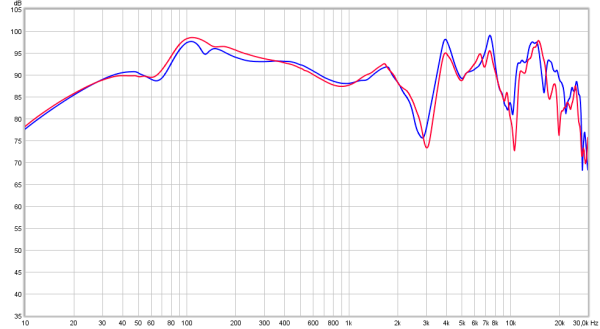
The upper bass (>100Hz) is elevated and the downwards slope towards 1kHz gives the AH-GC30 a warm/full sound. Where the AH-GC20 severely lacked clarity the AH-GC30 does this a lot better. The dip at 3kHz still makes the sound a bit too laid-back/lush. The elevated 4kHz and 8kHz region gives some sharpness to the sound. The upper treble (>10kHz) is elevated a bit and makes cymbals stand out.
Again… in a lush way.
Because I could not get my measurement gear to work with B.T. another method for measuring the frequency response was used. This works by recording a white noise for 1 minute and playing that file (using a Honor 6X phone in this case) and recording the received sound. Also the ‘wired’ plots are coming from the Honor 6X phone.
Note the lowest frequency is 150Hz (instead of the usual 20Hz)
Below the measurement of the AH-GC30 in passive mode and wired. (left channel) The results are the same as when measured in the usual way even when driven from the output of a mobile phone.
The results are the same as when measured in the usual way even when driven from the output of a mobile phone.
Below the frequency response with N.C. off using the same method but using the BlueTooth connection.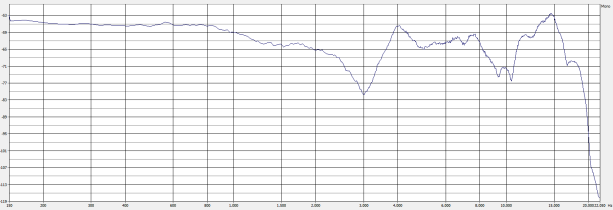 Using the BT connection it is obvious the amount of lower mids and bass is a fair bit higher (almost 6dB) compared to using it wired.
Using the BT connection it is obvious the amount of lower mids and bass is a fair bit higher (almost 6dB) compared to using it wired.
When the headphone’s Noise Cancelling circuit is switched on. Because of this the subdued upper mids become a bit more subdued and are a bit too low in level when one prefers clarity.
Below the N.C. is in ‘airplane‘ mode versus passive mode. This is the first mode one enters when switching the N.C. on.
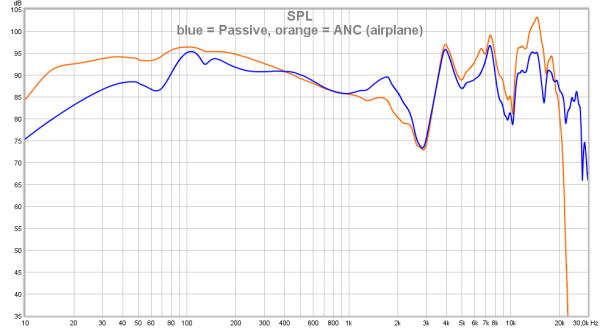
The sound lacks ‘clarity/presence’ and is even more overly ‘laid-back’ and V-shaped.
The treble still sounds ‘soft’ in texture but is noticeably more present and still ‘pleasant’.
Below the measurement using the wired connection from the Honor 6X phone. Wired and N.C. on.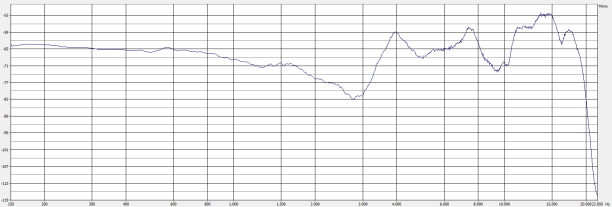
Below the measurement using the Bluetooth connection from the Honor 6X phone with N.C. on.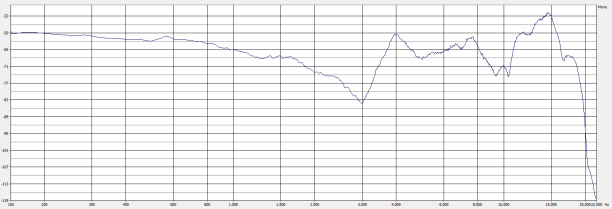 Aside from the obvious level differences there is not much difference in tonality between the wired and BT connection in N.C. mode.
Aside from the obvious level differences there is not much difference in tonality between the wired and BT connection in N.C. mode.
The 3 different N.C. modes also have a different tonal balance so you could use those different modes as a kind of tone control presets. Below passive mode, airplane mode, city mode and office mode.
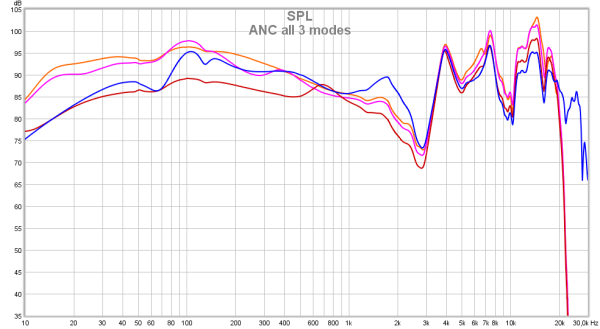 What is clearly visible is the active modes cut off all signals above 20kHz indicating that the N.C. is digital. The tonal balance changes substantially in the office mode.
What is clearly visible is the active modes cut off all signals above 20kHz indicating that the N.C. is digital. The tonal balance changes substantially in the office mode.
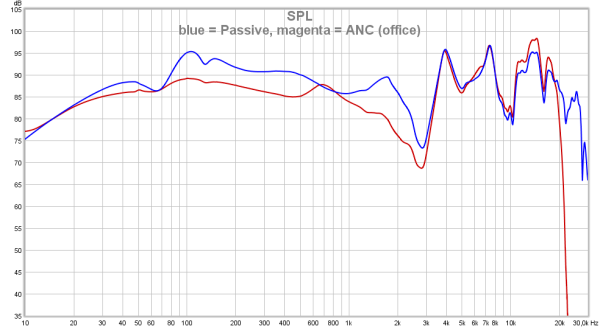 In office mode the sharpness is more obvious and ‘warmth’ is much lower. This does not help the overall sound quality and the ‘lushness’ is now gone.
In office mode the sharpness is more obvious and ‘warmth’ is much lower. This does not help the overall sound quality and the ‘lushness’ is now gone.
As the maximum frequency range is 20kHz it makes no sense to play anything with bitrates above 44.1kHz (Hi-Res recordings) when using the N.C. function nor with the B.T. connection.
(Direct USB functionality is not tested)
compared to AH-GC20
Below the AH-GC20 (wired in passive mode) versus the AH-GC30 (wired in passive mode)
 There is a substantial difference between the AH-GC20 and AH-GC30 when it comes to usability in passive mode. Where the AH-GC20 was not really usable the AH-GC30 sounds much better in passive mode. The AH-GC30, being closed, already has a more than decent passive attenuation in most cases one does not even need to use the N.C. functionality.
There is a substantial difference between the AH-GC20 and AH-GC30 when it comes to usability in passive mode. Where the AH-GC20 was not really usable the AH-GC30 sounds much better in passive mode. The AH-GC30, being closed, already has a more than decent passive attenuation in most cases one does not even need to use the N.C. functionality.
In active (Noise Cancelling) mode the differences between the models are are more alike but still different.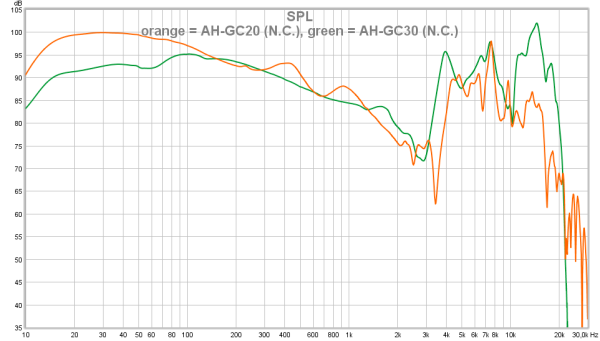 The AH-GC20 is a bit boomier and the treble is subdued a little. The AH-GC30 is improved a bit and has noticeable higher treble energy. There is a sharpness to the sound in the AH-GC30 which the AH-GC20 does not have.
The AH-GC20 is a bit boomier and the treble is subdued a little. The AH-GC30 is improved a bit and has noticeable higher treble energy. There is a sharpness to the sound in the AH-GC30 which the AH-GC20 does not have.
The AH-GC30 is certainly an upgrade over the AH-GC20 in many aspects. The difference between wired (passive) mode is huge.
compared to
Below the AH-GC30 compared to some other N.C. headphones (all with N.C. on)

Below the AH-GC30 compared to some other wireless (B.T.) headphones.
All measured headphones were measured using a wired connection. So not using the actual B.T. connection which in some cases differs from the wired connection. The AH-GC30 was used in N.C. mode.
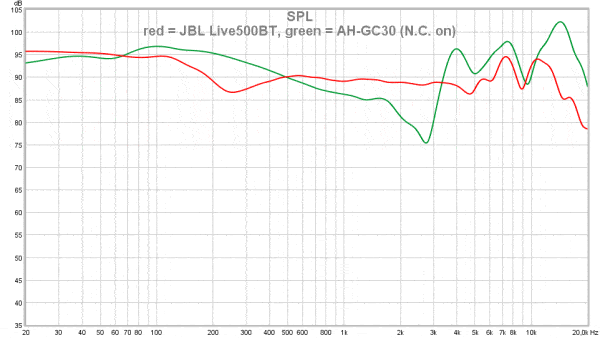
Below the AH-GC30 compared to some other wired headphones with a similar warm/bassy tonal balance. The AH-GC30 was used in N.C. mode.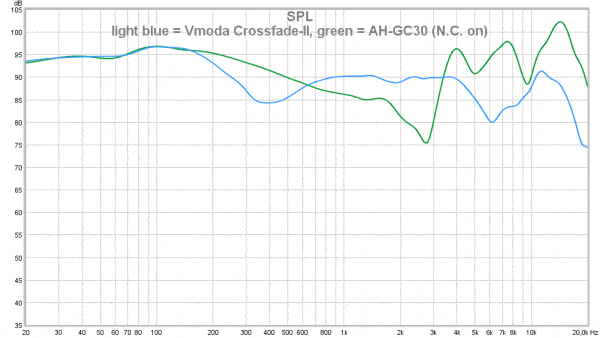 The elevated treble of the AH-GC30 stands out quite a bit when compared to the elevated lows.
The elevated treble of the AH-GC30 stands out quite a bit when compared to the elevated lows.
phase
Below the phase response of the AH-GC30 in passive (wired) mode (left, right)
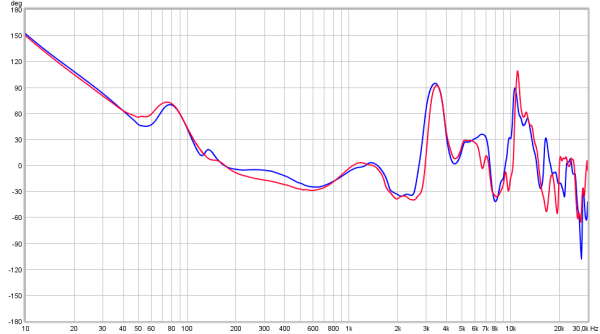
Gentle sloping phase is not audible. Around 3kHz and 10kHz there are substantial (120°) and steep phase shifts present. This indicates that the drivers have some difficulties in those parts of the frequency range.
The amplitude variation aspects far outweigh the effects of the phase shifts though.
In N.C. mode the absolute polarity is inverted. (right channel is shown only but present on both channels)
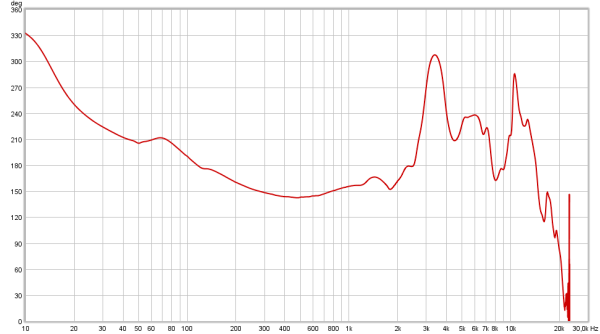 The positive effect of the acoustic feedback of the N.C. circuit is visible up to 2kHz. Above that frequency the N.C. does not work anymore.
The positive effect of the acoustic feedback of the N.C. circuit is visible up to 2kHz. Above that frequency the N.C. does not work anymore.
Seal
Closed headphones usually depend on a good seal (pads sealing off properly all around the ear) to get a good subbass response. This headphone is not different. At least not in passive mode. Below the AH-GC30 in passive mode measured with a perfect seal, wearing thick armed (reading-/sun-glasses) that sit flush against the skin, wearing thin armed that are not flush against the skin and wearing thick armed that do not rest against the skin.
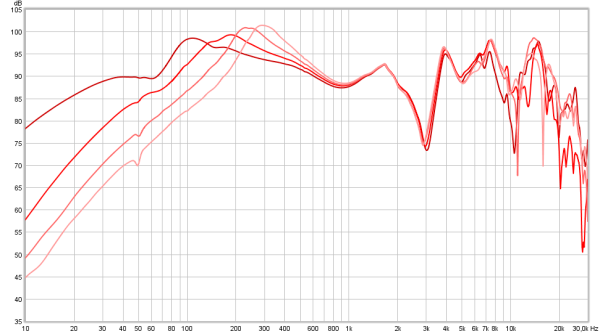 As can be seen to get the proper amount of bass a good seal is important in passive mode (switched off).
As can be seen to get the proper amount of bass a good seal is important in passive mode (switched off).
In N.C. mode the lower bass roll-off that occurs due to leakage is mostly compensated for by the Noise Cancelling. Below the same conditions but with N.C. on (airplane mode).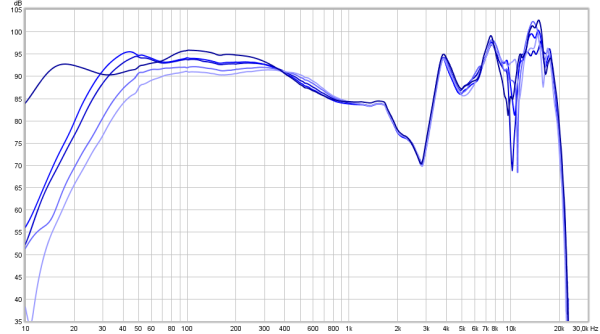 The positive effects of the Noise Cancelling circuit is quite obvious here.
The positive effects of the Noise Cancelling circuit is quite obvious here.
There still is some roll-off but not in the same extremes as when in passive mode or BT mode without N.C. on.
damping factor/output resistance (passive mode only)
A higher output resistance from an amplifier can affect the tonal balance of a headphone. This is dependent on the impedance of the driver as that can vary depending on frequency.
Of course the plots below are only valid when connected directly to an amplifier using the 3.5mm TRS plug. When using a BT connection this isn’t applicable.
Below the effect of a (0.2Ω, 10Ω, 33Ω and 120Ω) output resistance on the tonal balance. One should realize that output resistance on phones/tablets/laptops usually is close to 0Ω. On a higher output resistance amplifier (AVR, receivers, tube gear, studio interfaces) the effect is shown below.
The output level will be lower of course due to voltage division. To compensate for this the amplifier is cranked up to the same level (20dB for 120Ω at 1kHz in this case). This way the plots are overlaid and it is easier to see how the tonal balance changes. Output resistances between the mentioned resistance values will result in tonal changes between those traces.
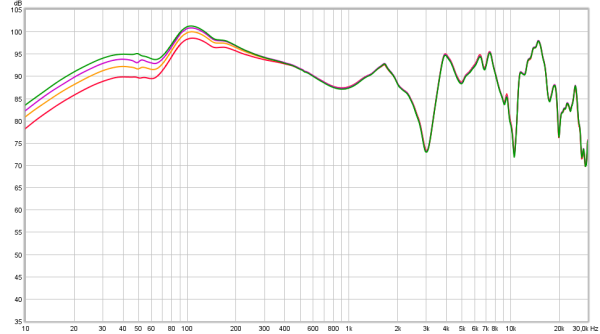 The tonal balance does not change much so driving this headphone from a higher output resistance source isn’t going to make the dark sound signature even darker or the bass any more bloated than it already is. The effect that is seen here appears to be caused by the driver being in parallel to the input circuit of the internal electronics (high pass filter) rather than the effects coming from a rise in impedance of the driver.
The tonal balance does not change much so driving this headphone from a higher output resistance source isn’t going to make the dark sound signature even darker or the bass any more bloated than it already is. The effect that is seen here appears to be caused by the driver being in parallel to the input circuit of the internal electronics (high pass filter) rather than the effects coming from a rise in impedance of the driver.
The DC resistance that is measured is 26Ω (the actual driver impedance) but at 1kHz the impedance drops to 13Ω as the input circuit of the analog input is also 26Ω but through a coupling capacitor (100Hz, -3dB).
In active mode (N.C. on) the attenuation is less (14.8dB) due to the input resistance of the headphone being higher (26Ω). measured with 0.2Ω, 10Ω, 33Ω and 120Ω output resistance.
 It appears as though some of filtering is done at the input of the active electronics already given the deviating response with output resistances < 33Ω.
It appears as though some of filtering is done at the input of the active electronics already given the deviating response with output resistances < 33Ω.
In BlueTooth mode the output resistance of the source of course thus doesn’t matter.
Below the distortion plot of the AH-GC30 with the power switch in the off position.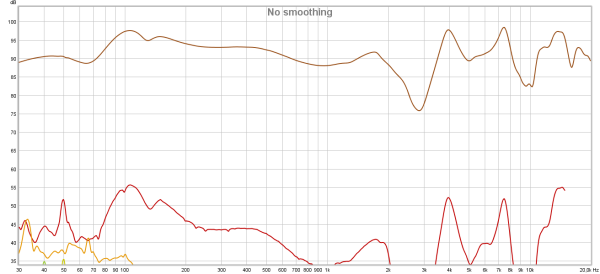
Below the same plot but shown in percentage scale.
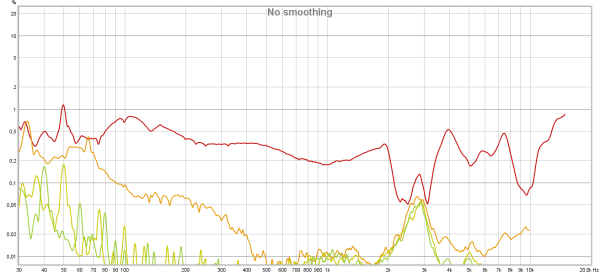 Small drivers usually show an increase in distortion at lower frequencies but less so for closed headphones. Distortion overall is pretty low.
Small drivers usually show an increase in distortion at lower frequencies but less so for closed headphones. Distortion overall is pretty low.
The 2nd harmonic distortion in the mids will most likely be below the shown 0.2% as this is the measurement limit of my measurement system.
Below the distortion plot of the AH-GC30 with the Noise Cancelling on (percentage scale only).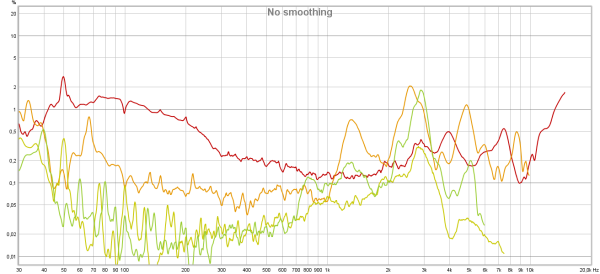 Distortion in the bass area has not improved much. Higher harmonic distortion is increased above 1kHz.
Distortion in the bass area has not improved much. Higher harmonic distortion is increased above 1kHz.
Most likely this is caused by the N.C. circuit becoming less effective above 1kHz. Unfortunately this is in a part of the frequency range where the hearing is most sensitive.
Below the CSD (Waterfall plot) of the AH-GC30 in passive mode. Right and left channel are superimposed. Just below 2kHz there is a resonance visible just like at 4kHz, 7kHz and 15kHz.
Just below 2kHz there is a resonance visible just like at 4kHz, 7kHz and 15kHz.
The duration of the ringing is not problematic but the plot does reveal the driver has some resonance issues.
Another form of looking in the time domain is the spectrum plot. The amplitude is color coded and both the time scale and frequency scale differ as well. Below in passive mode.
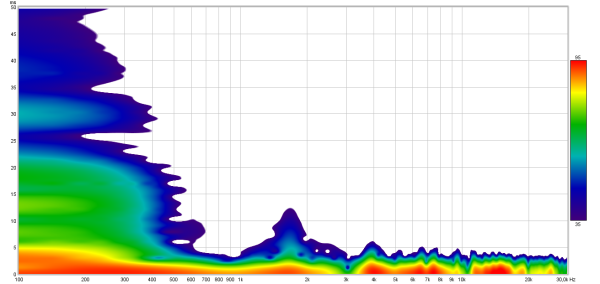
There is some lingering in the lows and the resonance just below 2kHz is visible.
Below the same plot but with N.C. on (airplane mode)
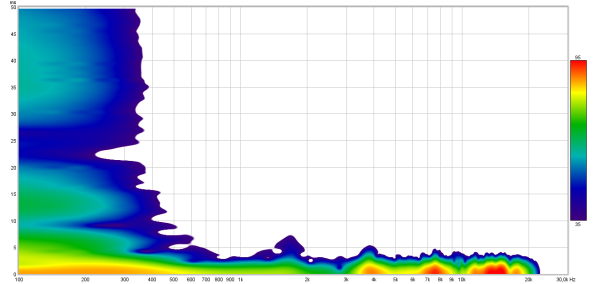 The benefits of the Noise Cancelling circuit is obvious below 3kHz where resonances are shorter in duration.
The benefits of the Noise Cancelling circuit is obvious below 3kHz where resonances are shorter in duration.
step response
Below the step response with a dB scale (so not similar to an oscilloscope plot). In passive mode (wired)
(left, right)
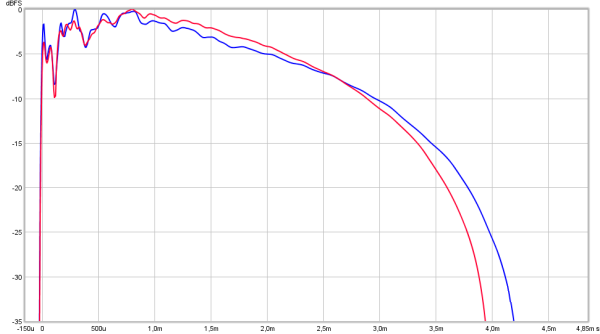 The rising edge reaches -2dB but is at -5dB in the first 200μs and then rises to 0dB. This shows the ‘lush’ character (lacking ‘bite’). From 1.5ms the response drops more quickly indicating a lack of sub-bass extension in passive mode.
The rising edge reaches -2dB but is at -5dB in the first 200μs and then rises to 0dB. This shows the ‘lush’ character (lacking ‘bite’). From 1.5ms the response drops more quickly indicating a lack of sub-bass extension in passive mode.
In active mode (Airplane mode) the response changes. (left channel shown only)
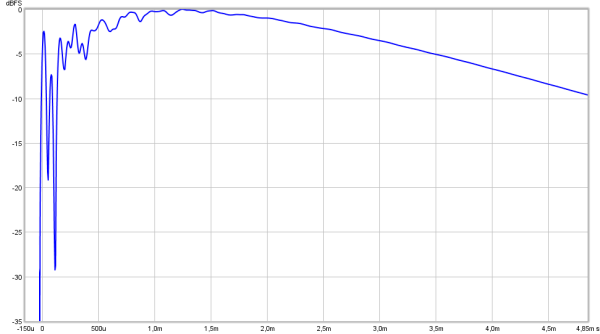 The initial rise is higher still reaches -2dB so there is enough ‘sharpness’. In the first 200μs the response drops a bit more than in passive mode. The rise in response from 400μs to 1ms shows the warmth.
The initial rise is higher still reaches -2dB so there is enough ‘sharpness’. In the first 200μs the response drops a bit more than in passive mode. The rise in response from 400μs to 1ms shows the warmth.
The sub-bass extension is very good due to the corrections made by the Noise Cancelling circuit. The drop in response after 2ms is small and gradual.
Group Delay
Below the Group Delay plot of the AH-GC30 in passive mode. It shows some pad bounce in the 50Hz t0 150Hz region and resonances between 3 and 4kHz as well as around 10kHz.
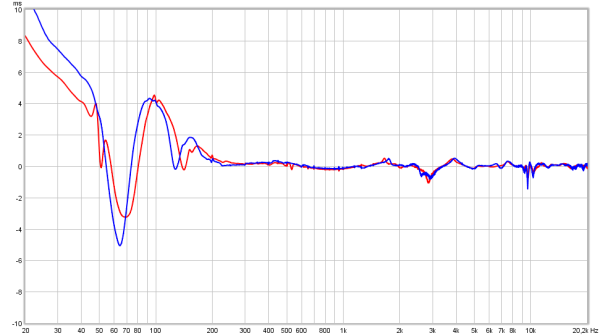
conclusion
The Denon AH-GC30 is a luxury looking and feeling wireless headphone with Noise Cancelling option with a warm and ‘lush’ sound with elevated lows and treble.
People looking for a ‘neutral/natural’ sound should look elsewhere. The closest thing to neutral is using this headphone wired without N.C. on. Even in that case it is not exactly neutral.
People looking for a luxury headphone with a ‘lush’ sound, B.T. connection and Noise Cancelling and willing to spend around $ 300.- also have the option to choose between Sony WH1000X(M3/4/5), Bose QC35/45, Sennheiser Momentum 4, AKG N700NC.
The AH-GC30 will have the most luxury feel/looks but the other ones sound a bit more realistic.
The Denon runs about 20 hours on a single battery charge and when the batteries are depleted the headphone can be used passively using the supplied 3.5mm cables. That is if the used sound source has a 3.5mm output which is not always the case these days.
CTIA compliant devices (Apple and most modern phones) can use the included 3.5mm cable with the remote/mic in it when the battery is depleted and still use some basic functions.
Of course the headphone can also be used to take phone calls and operate some music player functions and control the volume.
Another handy function is to use the USB cable not only for charging but also as a digital music transfer method directly from a phone/laptop/tablet/PC USB output.
There are no fancy tone controls or other special functions. These would have to come from the music source, for instance using the free Denon audio smartphone app.
The travel case, the way it collapses in a small form makes it easy to take it along. There is no airplane adapter nor a 6.3mm adapter included and would have to be bought separately (if needed).
Something to consider: The batteries and earpads are not user replaceable. Batteries usually last several years but eventually they will last shorter and shorter after a few years.
By then there will be a newer and better model so there’s that.
